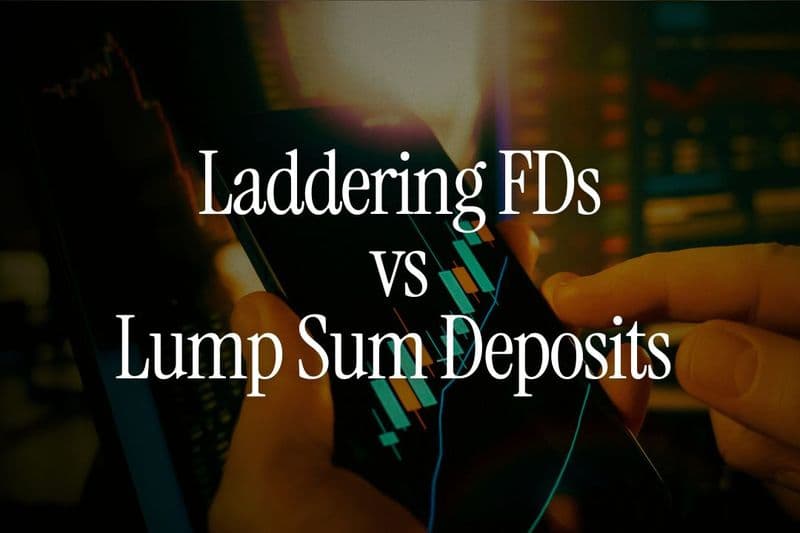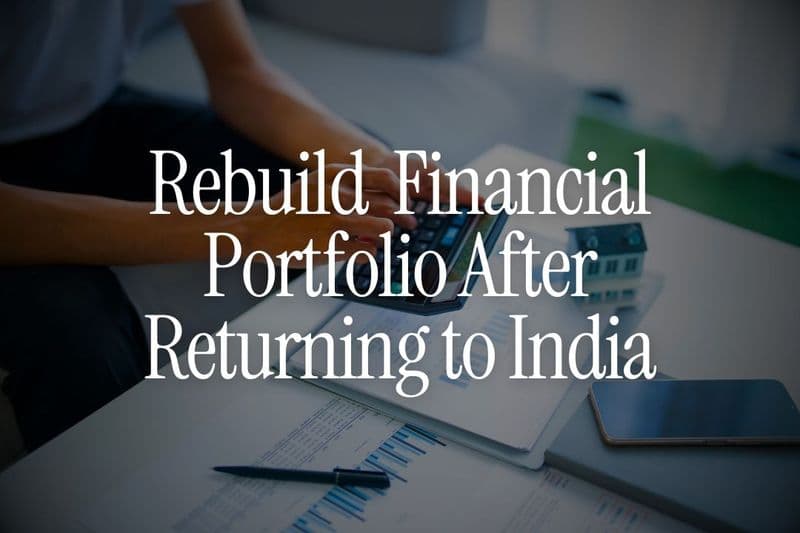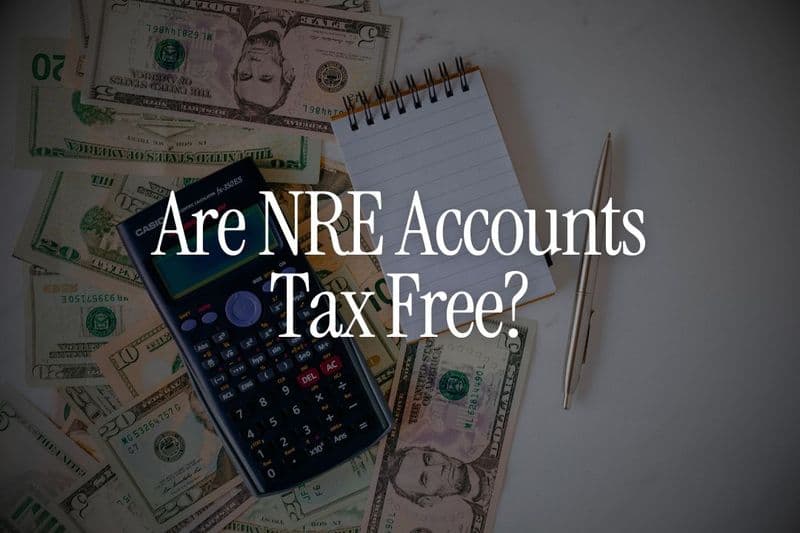
Rajesh, 62, just retired from his engineering job in Dubai. He has $400,000 saved and wants to move it to India for retirement.
His plan: convert everything to INR, put it in a 5-year fixed deposit at 7% interest, and live off the monthly interest payments.
Simple, safe, predictable. What could go wrong?
We asked him: "What happens when interest rates drop to 5.5% five years from now? What if the rupee crashes from ₹88 to ₹95 per dollar? What if you need emergency funds in year three?"
Rajesh paused. These questions hadn't crossed his mind.
At Belong, we've worked with hundreds of NRI retirees through our advisory services and WhatsApp community. We've seen brilliant professionals make costly retirement mistakes - not because they weren't smart, but because they didn't know the questions to ask.
This article answers everything about FD laddering vs lump sum deposits for retirement income. We'll show you real numbers, tax implications, currency risks, and exactly when each strategy makes sense.
By the end, you'll know precisely which approach fits your retirement plan.
What Is a Lump Sum FD Deposit?
A lump sum FD deposit means putting your entire retirement corpus into one or a few large fixed deposits at the current interest rate.
Example: You have ₹3 crores. You invest:
- ₹1 crore in HDFC 5-year FD at 6.15%
- ₹1 crore in ICICI 5-year FD at 6.60%
- ₹1 crore in SBI 5-year FD at 6.05%
You choose monthly interest payout. Every month, you receive approximately ₹1.75 lakhs across all three FDs.
The appeal is obvious:
- Maximum interest rate (longer tenures typically pay more)
- Simple to manage (just three FDs)
- Predictable monthly income
- No reinvestment decisions for 5 years
The hidden risks are less obvious:
- Locked at one interest rate for 5 years
- If rates rise, you miss out entirely
- Breaking FDs early means penalties (0.5-1% rate reduction)
- All eggs in one interest rate basket
- No flexibility if your needs change
Lump sum deposits worked well when:
- Interest rates were stable or falling
- Inflation was predictable
- Retirees had pensions for base income
- Life was less uncertain
But things have changed.
What Is FD Laddering?
FD laddering splits your corpus across multiple fixed deposits with staggered maturity dates.
Instead of one big FD, you create a "ladder" where deposits mature at regular intervals - giving you recurring access to funds you can either withdraw or reinvest.
Example with ₹50 lakhs:
Instead of putting all ₹50 lakhs in one 5-year FD, you build a ladder:
FD Number | Amount | Tenure | Maturity |
|---|---|---|---|
FD 1 | ₹10 lakhs | 1 year | Year 1 |
FD 2 | ₹10 lakhs | 2 years | Year 2 |
FD 3 | ₹10 lakhs | 3 years | Year 3 |
FD 4 | ₹10 lakhs | 4 years | Year 4 |
FD 5 | ₹10 lakhs | 5 years | Year 5 |
What happens each year:
Year 1: FD 1 matures. You can:
- Withdraw ₹10 lakhs if needed
- Reinvest in a new 5-year FD at current rates
Year 2: FD 2 matures. Same choice.
Year 3: FD 3 matures. Same choice.
By Year 5, you have a rolling ladder where one FD matures every year, giving you:
- Regular liquidity
- Opportunity to capture higher rates if they rise
- Protection against being locked in at low rates
- Flexibility to adjust strategy as needs change
👉 Tip: Senior citizens get an extra 0.50% interest rate at most banks. If you're 60+, factor this into your calculations.
The ladder keeps rolling. Every year, as one FD matures, you reinvest it for another 5 years at the current rate. You always have access to funds without penalties.
Head-to-Head Comparison: Lump Sum vs Laddering
Let's compare both strategies across seven dimensions that matter for retirement cash flow.
Factor | Lump Sum FD | FD Laddering | Winner |
|---|---|---|---|
Interest Rate | Locked at current rate for full tenure | Partially protected - reinvest at new rates regularly | Laddering |
Liquidity/Emergency Access | Must break FD (0.5-1% penalty) | Regular maturities provide penalty-free access | Laddering |
Simplicity | Very simple - set and forget | Slightly complex - requires tracking | Lump Sum |
Total Returns (Rising Rates) | Miss out on higher rates | Capture rising rates gradually | Laddering |
Total Returns (Falling Rates) | Benefit from locking high rate early | Gradually exposed to lower rates | Lump Sum |
Cash Flow Predictability | Highly predictable for full tenure | Predictable short-term, variable long-term | Lump Sum |
Risk of Rate Timing Error | High - wrong timing locks you in | Lower - spread across multiple entry points | Laddering |
Key insight: Laddering protects against the unknown. Lump sum bets everything on current rates staying attractive.
When Lump Sum FDs Make More Sense
Lump sum isn't always the wrong choice. Here are scenarios where it works better:
1. Interest Rates at Multi-Year Highs
If current FD rates are at 8-9% (historically high for India) and you believe they'll fall, locking in the high rate for 5-7 years makes sense.
Example: In 2013, some banks offered 9-10% on 5-year FDs. Investors who locked in those rates benefited significantly as rates fell to 5-6% by 2020.
We track historical rates on our NRI FD rates comparison tool.
2. Large Corpus with Other Income Sources
If you have ₹5-10 crores in FDs and also have rental income, pension, or annuities, a lump sum approach simplifies management.
The interest income from FDs is supplementary, not primary, so flexibility matters less.
3. Very Conservative Risk Profile
Some retirees value simplicity and predictability above optimization. They want to know exactly what they'll receive every month for the next 5 years, period.
If you lose sleep thinking about reinvestment decisions, lump sum reduces mental burden.
4. Short Investment Horizon
If you're 75+ and your planning horizon is 5-7 years max, creating a complex ladder offers marginal benefits.
A simple lump sum strategy matched to your timeline makes sense.
5. Already Diversified Across Asset Classes
If FDs are just 20-30% of your portfolio and you have equity, mutual funds, property generating income, then optimizing FD structure matters less.
You can afford to keep FDs simple.
👉 Tip: Never put more than 40% of your retirement corpus in FDs alone. Inflation will erode purchasing power. Mix with equity mutual funds, debt funds, or real estate.
When FD Laddering Wins Decisively
For most NRI retirees, laddering is the smarter strategy. Here's when it's clearly superior:
1. Uncertain Interest Rate Environment
When rates are volatile or in the middle of a cycle (neither very high nor very low), laddering protects you.
You're not betting on rate direction - you're capturing whatever rates do over time.
Current scenario (November 2025): RBI has been adjusting rates. NRE FD rates range from 6.5-7.3%. Laddering makes sense because:
- Rates might rise if inflation stays elevated
- Rates might fall if growth slows
- No one knows for certain
Laddering eliminates the need to be right about rate forecasts.
2. FDs Are Your Primary Retirement Income
If you're relying heavily on FD interest for monthly expenses, liquidity is critical.
Example: ₹2 crore corpus generating ₹1.2 lakh monthly interest. This is your main income.
With laddering:
- Year 1: ₹40 lakhs matures → access without penalty if emergency
- Year 2: Another ₹40 lakhs matures → same
- Year 3-5: Same pattern continues
With lump sum:
- Emergency in Year 2 → break ₹2 crore FD → lose 0.5-1% interest → costly
Also Read - Building a Retirement Portfolio with Tax-Free Options in GIFT City
3. Longer Retirement Horizon (15-25 Years)
If you're retiring at 55-60 and expect to live to 80-85, that's a 20-25 year timeline.
Interest rates will change multiple times. Laddering ensures you're not stuck with 2025 rates in 2035.
4. Want to Match Cash Flows with Expenses
Some expenses are predictable: annual property tax, insurance premiums, child's college fees, vacation budget.
You can structure your ladder so FDs mature exactly when you need large payments.
Example structure:
- 1-year FD: ₹15 lakhs (for year 1 property tax + annual expenses)
- 2-year FD: ₹20 lakhs (for daughter's tuition Year 2)
- 3-year FD: ₹25 lakhs (car replacement Year 3)
- 4-5 year FDs: Regular retirement income
This is "liability matching" - aligning assets with liabilities.
5. Returning to India (RNOR Status Advantage)
NRIs returning to India often qualify for Resident but Not Ordinarily Resident (RNOR status) for initial years.
During RNOR status, foreign income is tax-free in India.
Laddering lets you time FD maturities to coincide with RNOR years, minimizing tax.
👉 Tip: Use our Residential Status Calculator to determine your RNOR eligibility. It can save lakhs in taxes.
Also Read -What Happens to Your NRI Account When You Return to India
How to Build Your Retirement FD Ladder (Step-by-Step)
Let's build a real retirement ladder with ₹1 crore corpus.
Step 1: Decide Your Income Need vs Reinvestment Need
Not all retirees want monthly income immediately. Some want corpus growth for a few years before drawing income.
Option A: Immediate Income Ladder Choose interest payout on all FDs, ladder the principal for liquidity.
Option B: Growth-then-Income Ladder Reinvest interest for first few years (compounding), then switch to payout mode.
Let's assume you want immediate monthly income. Total corpus: ₹1 crore.
Step 2: Divide Corpus Across Rungs
We recommend a 5-rung ladder for most retirees. Divide ₹1 crore into 5 parts of ₹20 lakhs each.
Rung | Principal | Tenure | Interest Rate* | Annual Interest | Monthly Interest |
|---|---|---|---|---|---|
1 | ₹20 lakhs | 1 year | 7.00% | ₹1,40,000 | ₹11,667 |
2 | ₹20 lakhs | 2 years | 6.90% | ₹1,38,000 | ₹11,500 |
3 | ₹20 lakhs | 3 years | 6.90% | ₹1,38,000 | ₹11,500 |
4 | ₹20 lakhs | 4 years | 6.65% | ₹1,33,000 | ₹11,083 |
5 | ₹20 lakhs | 5 years | 6.65% | ₹1,33,000 | ₹11,083 |
*Indicative NRE FD rates for Nov 2025 - verify current rates on our FD rates tool
- Total monthly income: ₹56,833
Year 1 Plan:
- Receive ₹56,833/month as interest
- At year-end, Rung 1 matures → ₹20 lakhs available
Decision at Rung 1 maturity:
- If interest rates rose to 7.5%: Reinvest ₹20 lakhs in new 5-year FD at 7.5%. Your monthly income increases to ₹57,700.
- If rates fell to 6.5%: Reinvest at 6.5%. Monthly income drops slightly to ₹56,000.
- If emergency: Don't reinvest. Use ₹20 lakhs for medical/family need.
Step 3: Choose Banks Wisely
Don't put all rungs in one bank. Spread across 3-4 banks for:
- DICGC insurance protection (₹5 lakhs per bank, per depositor)
- Rate optimization (different banks offer different rates)
- Risk diversification
Suggested split for ₹1 crore:
- ₹30 lakhs: ICICI Bank NRE FD
- ₹30 lakhs: HDFC Bank NRE FD
- ₹20 lakhs: SBI NRE FD
- ₹20 lakhs: Axis/IndusInd (whoever offers highest rate)
Also Read - Which bank is best for fixed deposit in india
Step 4: Set Up Auto-Renewal (With Caution)
Most banks offer auto-renewal. The FD automatically renews for the same tenure at maturity.
Pros:
- No action needed
- Continuity maintained
- Compounding continues
Cons:
- May miss better rates elsewhere
- Can't adjust strategy
- No manual review trigger
Our recommendation: Set auto-renewal OFF. Mark calendar 30 days before each maturity. Review rates, assess needs, make conscious decision.
Step 5: Track and Adjust Annually
Create a simple spreadsheet or use our tools:
Maturity Date | Bank | Principal | Tenure | Rate | Action Needed |
|---|---|---|---|---|---|
Nov 15, 2026 | ICICI | ₹20L | 1yr | 6.25% | Renew/withdraw |
Nov 15, 2027 | HDFC | ₹20L | 2yr | 6.45% | Renew/withdraw |
Set annual reminders. Reevaluate strategy based on:
- Rate environment
- Health/emergency needs
- Tax situation
- Currency outlook
👉 Tip: Join our WhatsApp community where we share monthly FD rate updates and help members optimize their ladders.
The NRI Complication: Currency Risk Changes Everything
Everything we've discussed assumes you're comfortable with rupee risk. But here's the reality for NRIs:
NRE FDs are denominated in rupees.
You deposit USD/AED/GBP → converts to INR → earns interest in INR → converts back to foreign currency when you repatriate.
This exposes you to currency fluctuation risk.
Real Example: 10-Year FD Journey
2015: Sunil, an NRI in Dubai, invests $100,000 at ₹65/$ = ₹65 lakhs in 5-year NRE FD at 8.5% interest.
2020: FD matures. ₹65 lakhs + interest = ₹98 lakhs total.
Repatriation: ₹98 lakhs ÷ ₹75/$ = $130,667
Gain in USD terms: 30.67% over 5 years = ~5.5% CAGR
But consider:
- Indian FD gave 8.5% interest
- Currency depreciation (₹65→₹75) ate ~3% annually
- Net gain: ~5.5% in USD terms
What if rupee crashed to ₹85/$? ₹98 lakhs ÷ ₹85/$ = $115,294 Gain in USD: Only 15.3% over 5 years = ~2.9% CAGR
Currency risk can erase half your FD returns.
Historical Reality Check
Here's what happened to NRI FD returns in USD terms over the past decade:
Period | INR FD Rate | ₹ Depreciation | USD Return |
|---|---|---|---|
2013-2018 | 8.5% | ~3% annually | ~5.5% |
2018-2023 | 7.0% | ~2.5% annually | ~4.5% |
2023-2025 | 7.1% | ~1.5% annually | ~5.6% |
Source: RBI data on NEER/REER, bank FD archives
Currency matters more than most NRIs realize.
So what's the solution?
GIFT City USD Fixed Deposits: The Game-Changer
Gujarat International Finance Tec-City (GIFT City) operates under different rules.
You can invest in USD directly. No forced conversion to rupees.
How GIFT City USD FDs work:
You deposit: $100,000 It stays as: $100,000 (not converted to INR) Earns interest: 5.0% annually in USD Matures to: $105,000 first year (approximately, compounded)
Key benefits for NRI retirees:
1. Zero Currency Risk Your entire deposit stays in USD. If rupee crashes from ₹83 to ₹95, your USD principal is unaffected.
2. Tax-Free Interest Income Interest earned on GIFT City FDs is exempt from Indian income tax (unlike NRE FDs where interest is tax-free but principal faces TDS on NRO).
3. Simplified Repatriation Funds are already in USD/foreign currency. Repatriating to your overseas account is straightforward under IFSCA rules.
4. Lower But Stable Returns GIFT City USD FD rates are lower than INR rates (4.5-6% vs 6.5-7.5%) BUT:
- No currency depreciation eating returns
- No tax on interest
- Net effective return often better
Comparison: NRE FD vs GIFT City USD FD
Let's compare with real numbers over 5 years:
Scenario A: NRE FD
- Initial: $100,000 → ₹88,00,000 (at ₹88/$)
- Interest rate: 6.8% annually
- After 5 years: ₹1,24,00,000 (approx.)
- Rupee depreciates to ₹95/$
- Convert back: ₹1,24,00,000 ÷ 95 = $130,526
- Return: 30.5% in USD over 5 years = 5.5% CAGR
- Tax: TDS may apply depending on residential status
Scenario B: GIFT City USD FD
- Initial: $100,000 (stays in USD)
- Interest rate: 6.0% annually
- After 5 years: $133,823 (compounded)
- No currency risk
- Return: 33.8% over 5 years = 6.0% CAGR
- Tax: Interest exempt from Indian tax
Key insight: GIFT City gives 0.4% lower CAGR but with ZERO currency risk and tax-free interest.
For risk-adjusted returns, GIFT City often wins.
Can you ladder GIFT City USD FDs?
Absolutely. We've built hundreds of USD FD ladders for NRI retirees.
Example: $300,000 USD ladder
- $60,000 in 1-year USD FD
- $60,000 in 2-year USD FD
- $60,000 in 3-year USD FD
- $60,000 in 4-year USD FD
- $60,000 in 5-year USD FD
Every year one FD matures, giving you $60,000+ to reinvest or withdraw.
We explain the complete process in our GIFT City NRI Fixed Deposits guide.
👉 Tip: At Belong, we offer GIFT City USD FDs starting from $10,000. Our clients ladder across multiple tenures for liquidity. Download the app to explore current rates.
Tax Treatment: Laddering vs Lump Sum
Both strategies face the same tax rules, but laddering offers better tax management.
For NRIs with NRE FDs:
Interest income: Tax-free in India (no TDS deducted)
Tax in country of residence: Depends on that country's laws. Most countries (UAE, UK, US, Singapore) tax worldwide income.
DTAA benefit: India has Double Taxation Avoidance Agreements (DTAA) with most countries. You can claim credit for Indian taxes (if any) in your home country.
Laddering advantage: By staggering maturities, you can spread interest income across multiple years, potentially staying in lower tax brackets in your country of residence.
Example: Receiving ₹10 lakhs interest in one year might push you to a higher tax bracket. Spreading it as ₹3-4 lakhs annually keeps you in a lower bracket.
Also Read -DTAA for NRI Bank Interest: Can You Avoid 30% TDS Legally
For NRIs with NRO FDs:
Interest income: Taxable in India. TDS of 30% deducted automatically.
Laddering advantage: You can plan maturities around your residential status changes.
If you're returning to India and will be RNOR, time FD maturities during RNOR years when certain foreign income gets favorable treatment.
Also Read -Best NRO Accounts
For Returning Residents:
After becoming Resident in India:
Interest income is fully taxable at slab rates. Budget 2025 increased the basic exemption to ₹12 lakhs.
Smart strategy: Ladder small FDs to keep annual interest income under ₹12 lakhs → zero tax.
Example: ₹1.6 crore corpus at 7.2% = ₹11.52 lakhs annual interest → tax-free
Read our detailed analysis: Budget 2025 tax changes for NRIs returning to India.
👉 Tip: Use our Compliance Compass to check tax and regulatory requirements based on your residency status.
Real Examples from Our Community
Let us share two actual cases from our advisory work (names changed for privacy):
Case 1: Ramesh, 64, UAE-based, Returning to India
Situation:
- $350,000 saved (₹2.9 crores at ₹83/$)
- Retiring in 6 months, moving to Bangalore
- Needs ₹1.5 lakhs monthly for expenses
- Will qualify for RNOR status for 2 years
What he almost did: Put entire ₹2.9 crores in HDFC NRO 5-year FD at 7.2%, monthly interest payout.
Problems we identified:
- Entire corpus locked at ₹83/$ rate (currency risk)
- 30% TDS on all interest immediately
- No liquidity for emergencies
- Missing RNOR tax benefits
- All principal tied up for 5 years
What we recommended:
Strategy: Hybrid ladder across INR + USD
- ₹1.2 crores: Laddered across 5 NRO FDs (₹24 lakhs each, 1-5 years)
- $100,000: GIFT City USD FD 3-year tenure
- ₹50 lakhs: Senior Citizen Savings Scheme (SCSS) for tax-efficient income
- ₹1.2 crores: Conservative debt mutual funds for inflation protection
Results after 2 years:
- Monthly income: ₹1.65 lakhs (higher than target)
- Tax paid: ₹1.8 lakhs/year (vs ₹6.5 lakhs with original plan)
- Liquidity: ₹24 lakhs matured Year 1, accessible without penalty
- Currency protection: $100,000 unaffected by rupee depreciation
Case 2: Priya, 58, USA-based, Not Returning
Situation:
- $500,000 retirement savings
- Living in New Jersey, no plan to return to India
- Wants safe USD returns, not comfortable with equity volatility
- Looking for 4-5% USD returns
What she considered: US Treasury bonds (3-4%), US bank CDs (3.5-4%), dividend stocks (too volatile).
What we suggested:
Strategy: GIFT City USD FD ladder
- $100,000 → 1-year USD FD at 4.9%
- $100,000 → 2-year USD FD at 5.0%
- $100,000 → 3-year USD FD at 5.1%
- $100,000 → 4-year USD FD at 5.15%
- $100,000 → 5-year USD FD at 5.2%
Why this worked:
- Higher rates than US alternatives (5% vs 3.5%)
- Tax-free interest in India (she reports and pays tax only in US)
- Every year, $100,000+ matures → liquidity
- GIFT City IFSCA regulated → safety comparable to US
- Can repatriate to US account seamlessly
After 3 years:
- Effective yield: ~5.05% in USD
- Zero currency risk
- Already repatriated Year 1 maturity proceeds to US
- Reinvesting at current rates as each FD matures
👉 Tip: These strategies were personalized to each person's situation. Join our WhatsApp community to discuss your specific scenario with our advisors and peers.
Common Mistakes Retirees Make (We've Seen Them All)
Over the years, we've identified patterns of mistakes NRI retirees make with FD planning. Learn from others' errors:
Mistake 1: Ignoring Currency Risk Entirely
What happens: Invest $200,000 → ₹1.66 crores at ₹83/$. After 5 years, rupee at ₹95/$. Repatriate ₹2.3 crores → get only $242,000 back.
8.4% "growth" in dollars over 5 years. You thought you were getting 7.2% annually. Actual return: ~1.6% annually.
Fix: Diversify across INR and USD deposits. Use GIFT City for USD stability.
Mistake 2: Chasing 0.25% Extra Rate
We've seen retirees move ₹50 lakhs from HDFC (7.05%) to a small cooperative bank (7.3%) for 0.25% extra.
Risk: Small banks sometimes face financial stress. DICGC insurance covers only ₹5 lakhs.
Fix: Stick to scheduled commercial banks with strong ratings. The extra 0.25% isn't worth sleepless nights.
Mistake 3: Not Planning for Inflation
₹1 lakh monthly income feels comfortable today. In 10 years, it'll feel like ₹60,000 due to inflation.
FD interest rates don't adjust for inflation. You're losing purchasing power every year.
Fix: Allocate 30-40% of retirement corpus to inflation-beating assets (equity mutual funds, REITs, dividend stocks).
Mistake 4: Forgetting to Nominate
We had a client whose father passed away with ₹80 lakhs in FDs. No nomination. Legal heir process took 18 months.
Fix: Add nomination on EVERY FD. Update if circumstances change (marriage, divorce, birth).
Read: SEBI's new nomination rules for Demat and accounts.
Mistake 5: Auto-Renewing Without Review
Set auto-renewal years ago. Rates dropped from 7.5% to 6.5%. FDs keep renewing at falling rates. Never reviewed.
Fix: Disable auto-renewal. Set calendar reminders 30 days before each maturity. Review and decide actively.
Mistake 6: Putting 100% in FDs
FDs are safe but insufficient for 20-30 year retirements.
Reality check:
- FD rate: 7%
- Inflation: 6-7%
- Real return: 0-1%
You're barely keeping pace with inflation.
Fix: Age-based allocation:
- Age 60-65: 50% FDs, 30% debt funds, 20% equity
- Age 65-70: 60% FDs, 25% debt funds, 15% equity
- Age 70+: 70% FDs, 20% debt funds, 10% equity
Mistake 7: Not Understanding TDS Rules
"My bank deducted 30% TDS on NRO interest. I'm in the 20% tax bracket. Can't get refund because I didn't file ITR."
Fix: If TDS exceeds your actual tax liability, you MUST file ITR to claim refund. Maintain documentation.
Read our guide: How to avoid NRI tax payment penalties.
👉 Tip: Download the Belong app for personalized retirement planning tools, including FD ladder calculators and tax optimizers.
Quick Decision Framework: Which Strategy Is Right for You?
Still confused? Use this decision tree:
Choose LUMP SUM FDs if:
- Current FD rates are at multi-year highs (8%+)
- You have other income sources (pension, rent)
- You value simplicity over optimization
- Your investment horizon is short (\< 7 years)
- You're absolutely certain you won't need emergency access
- FDs are <30% of your total portfolio
Choose FD LADDERING if:
- FDs are your primary retirement income source
- You want regular liquidity without penalties
- Interest rates are uncertain or mid-cycle
- Your retirement horizon is 15+ years
- You want protection against rate changes
- You can manage slightly more complexity
Add GIFT CITY USD FDs if:
- You're worried about rupee depreciation
- You earn/spend in foreign currency (USD, AED, GBP)
- You want tax-free interest income
- You may not return to India permanently
- You want stable, predictable USD returns
- You have $10,000+ to invest
Our general recommendation for most NRI retirees:
A hybrid approach works best:
- 40% laddered NRE/NRO FDs (for rupee income, India spending)
- 30% GIFT City USD FD ladder (for currency safety)
- 20% debt mutual funds (for liquidity + inflation protection)
- 10% equity/gold (for long-term growth)
This balances safety, income, liquidity, and growth.
Taking Action: Your Next Steps
Knowledge without action changes nothing. Here's your week-by-week plan:
Week 1: Assessment
- Calculate total retirement corpus
- Determine monthly income needs
- Check current FD holdings and rates
- Assess currency risk exposure
Week 2: Strategy
- Decide lump sum vs ladder vs hybrid
- Choose INR-only vs INR+USD approach
- Calculate required FD corpus for target income
- Plan bank diversification
Week 3: Execution
- Open NRE/NRO accounts if you don't have them
- Transfer funds from abroad (use best forex rates)
- Book FDs with chosen laddering structure
- Add nominations on all FDs
Week 4: Automation
- Set calendar reminders for maturities
- Create spreadsheet to track ladder
- Mark tax dates (ITR filing if needed)
- Join communities for ongoing learning
Need help? Our team at Belong specializes in NRI retirement planning. We've helped clients structure ladders for corpus sizes from $50,000 to $2 million.
Two ways to get started:
Join our WhatsApp community - Free. 5000+ NRIs sharing experiences, asking questions, learning together.
Download the Belong app - Explore GIFT City USD FDs, compare NRI FD rates, use planning calculators, book appointments with advisors.
Start small if you want. Try laddering ₹10-20 lakhs first. See how it works. Scale up once comfortable.
Your retirement deserves better than a one-size-fits-all approach.
Sources & References:
Reserve Bank of India - Master Direction on NRI Accounts (2024)
IFSCA - GIFT City Investment Guidelines (2025)
Personal FN - FD Laddering for Retirees Report (2024)
Fincart - FD Laddering Benefits Analysis (2024)
Union Budget 2025 - Tax Changes for Retirees
Historical FD rate data - ICICI, HDFC, SBI, Axis Bank (2015-2025)
RBI Exchange Rate Archives - NEER/REER Data




